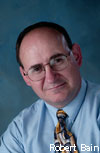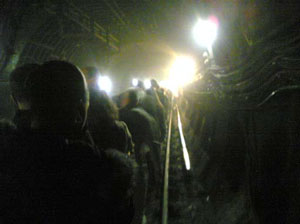 |
→ July 2005 Contents → Column
|
Camera Phones Prevail: Citizen Shutterbugs and the London Bombings
|
 |
||||||
|
San Jose, Calif. -July 9, 2005 - Photojournalism history was made last week. For the first time, both The New York Times and The Washington Post ran photos on their front pages made by citizen-journalists with camera phones.
Many years ago I found a cartoon of a tourist visiting hell. I think it may have come from the New Yorker, but it could have been Gary Larson's "Far Side" as well.
In the cartoon there is a tourist standing in line at the gates of hell with the devil standing proudly above the crowd in a sort of pose reminiscent of Napoleon. The line of people waiting to get into hell winds around through smoke, ash and flame. Then there is the tourist toward the back with his camera raised and pointed at the devil. I still chuckle a bit when I think about this cartoon and the increased advance of the digital camera and camera phones in society.
For the past year, I've been predicting how the camera phone will profoundly change the way people receive and mentally process news. I have oftentimes seen this trend as something that is to come - something in the future - but I was wrong.
There are now some 192 million cellphones being used in the U.S. and nearly 20 percent of them have cameras attached. In fact, Tony Henning, managing editor of the Mobile Imaging Report, is estimating that more than 300 million camera phones will be sold this year alone. If true, camera phones will outpace the sale of digital cameras by nearly 30 times greater.
The SmartMob blog is a good place to track what is happening with this new technology.
In London, during the attacks on the transit system, camera phones provided some of the most intense and immediate imagery from the scenes. The pictures were made by citizen shutterbugs, average people with an interest in sharing what they have experienced with others through e-mail messages.
Cian Donovan, according to The New York Times, went down into the London subway with a cellphone shortly after the blast and uploaded photos to his Flickr.com page. Now the world can see Donovan's images.
In fact, the "7/7 Community," formerly the London Bomb Blast Pool, as well as the London Moblog sites contain hundreds of images from the attacks.
Furthermore, the BBC obtained images from citizen shutterbugs and posted many of them to their news site following the incident. One well-composed and technically clean image was shot by an office worker looking down upon the destruction of a double-decker bus.
Many times these images are sent to family members first and then later find their way into the river of data that becomes public information. At times, some of these images are "picked up" by the mainstream media and disseminated as "real" news, which of course they can be.
Matea Gold of the Los Angeles Times reported that "because tight security prevented news crews from quickly reaching the bombing sites, the cellphone footage was all that was immediately available from underground. Its instant embrace by traditional news networks underscored how an evolving technology can take on new and unexpected roles."
Forbes' Zachary Seward reported in "Phones Offer Snapshot of Terror" that "even as photojournalists hit the streets to document the aftermath of the attacks, camera photos and video remained the most vivid illustrations of what had occurred. One video on the BBC showed an orderly but tense evacuation from a smoke-filled subway car; a shot of passengers walking along illuminated train tracks was the top photograph at NYTimes.com for several hours yesterday."
As was the case in the Abu Ghraib prison scandal, digital images and the Internet have circumvented the systems of control placed on society in the information age.
The camera phone is rapidly changing our visual landscape through its immediacy and interactional qualities. It is also changing the nature of how news is gathered and consumed.
In modern times, society has come to depend primarily on trained professionals to report what constitutes the news. News, in this configuration, however, has values which reporters, editors and photojournalists learn to prioritize, classify and categorize. Information is placed in a hierarchical order based on values such as relevancy, consequence, proximity, prominence, novelty and other values.
Washington Post staff writer Yuki Noguchi, in a story entitled, "Eyewitness Journalism: Camera Phones Lend Immediacy to Images of Disaster," reports that "camera phones, once a novelty, now outsell digital cameras by about 4 to 1, according to analyst data. As more sophisticated phones and higher-speed networks have become available, wireless companies have recently started offering video camcorders on their phones that can nearly instantly transmit moving pictures over e-mail or onto the Internet."
What this means potentially is that everyone is a visual communicator with a camera phone - everyone has the potential of contributing to shaping our perceptions of major and minor events happening around the world. As Noguchi observes, "The availability of the cameras, combined with the ability to transmit pictures and text instantaneously, is enabling the world to view news with nearly the immediacy of a victim or eyewitness."
Is having an army of citizen shutterbugs running fast and loose with digital cameras and camera phones a good thing for society? Is the ability to make and transmit images immediately after an event has occurred good for democracy, free speech, free will?
I think so ... I really think so.
I believe camera phones have the potential of providing yet another stream of information that can be used to help people understand, interpret, make sense of, and cope with life and all its complexities.
In an interview with The Associated Press following the release of the Abu Ghraib prison abuse photos last year, Washington Post Magazine photo editor Keith Jenkins, commented: "With the technology now, the amateur photographer is as capable as a professional journalist and is operating with the same tools: Digital camera, laptop and an Internet connection."
At the same time, make no mistake about it, camera phones will become part of a reporter's toolbox for information-gathering in the future. Photojournalists will carry them to communicate with editors immediately by sending digital snapshots of what they see before actually working with more professional cameras. Reporters will use camera phones to provide graphic designers on-the-scene visual references for information graphics and other visuals to package a story.
Bruce Rutledge (2003) argues: "Welcome to 21st-century journalism, where citizens armed with camera phones can instantly become reporters - or publishers. Today's mobile technology means you no longer need to be at a desk - or even own a computer - to e-mail a photo to a newspaper, or to publish an online magazine or blog. Now you can publish text and photos directly to the Web - or send them to your local paper - from a camera-enabled phone."
At the same time, folks like Al Tompkins on the Poynter Institute Web site questions the efficacy of news operations who use camera phone images from citizen shutterbugs. According to Thompkins, "There are tons of questions about how and whether newsrooms should publish or air such images:
- How do you know the image is authentic? - What do you know/need to know about how the image was captured? - What was the photographer's involvement in the incident he or she captured? - How do you keep from encouraging people to take unnecessary or dangerous risks in order to capture a photograph? - Will you compensate people for images? How will you decide how much to pay? - How much are you willing to compromise your standards of quality in order to use a cell image? - How easy is it for people to send you images and how easy is it for you to use them?
All the questions aside, the bigger issue is how will journalism adapt to an onslaught of independent content produce by CSers (citizen shutterbugs)?
Reading Washington Post columnist Robert MacMillan write about citizen journalism in his column "Random Access," I am inclined to think that we have been witnessing for some time now a significant turn in the information age - a turn toward not only the mass consumption of news from multiple sources but also the mass production of news from multiple sources.
MacMillian contends, "Citizen journalism is different. It often covers a wide territory, from soliciting arts and entertainment coverage to providing the angle on the city council budget that the cub reporter might have missed.
"The London attacks moved the trend to a new level. Web sites from the BBC's to the Guardian's provided eyewitness accounts, some showing up as little as an hour or two after the first bomb went off. Rather than relying on unfocused, rambling blog entries, the London papers and the Beeb ran pithy postings from the people who were there. They ran alongside the staff reporters' accounts and presumably with the same amount of editing."
How is the mainstream media responding to the deluge of images produced by CSers?
Will newspapers and television stations hire people just to sit in front of a computer to monitor all the photoblogs out there that might have images they can use?
As it now stands I do not believe that many of the individuals producing images during the London terrorist bombings have received any financial compensation for their efforts. Photo stringers typically receive between $75-$100 for pictures of events, but this is different. Traditionally, amateurs who have captured an important news event with a camera have sold their images to news sources, sometimes for great sums of money.
How does having hundreds of camera phones at the scene of a bomb blast change the course of news-gathering?
It is abundantly clear that the mainstream media will at first claim fair use of the images as they appear on sites like Flickr, Yahoo or Smugmug. They will encourage journalists not only to ask eyewitnesses if they have seen anything, but also if they might happen to have a camera phone in their pocket.
The mainstream media will now have to cull through thousands of news images that best fit their format and formula for determining what is news. Can you imagine what would happen now if an event like the 9/11 attacks on the World Trade towers occurred given the popularity of camera phones today?
What will happen when citizen shutterbugs start competing, as they already have, with news organizations for breaking news images?
Will there be a war of competition between media outlets in their lust for the most graphic and intense images produced by citizen shutterbugs?
Will citizen shutterbugs begin demanding money for their images?
What copyright issues are involved?
How will the average citizen, an individual who might become the subject of some horrific act like the London bomb blasts or 9/11, react to a fellow passerby making images of them without permission?
What will happen when citizen shutterbugs become more sophisticated with the use of software like Photoshop that will allow for the greater temptation of digital manipulation?
Indeed, I think the London situation brings us into a brave new world where, at present, there are more questions than answers.
© Dennis Dunleavy, Ph.D
Assistant Professor/Photojournalism Coordinator, School of Journalism and Mass Communications, San Jose University
See also: Evan Nisselson's prophetic May 2003 column, Why will wireless camera phones revolutionize the photography industry? |
|||||||
Back to July 2005 Contents
|
|

